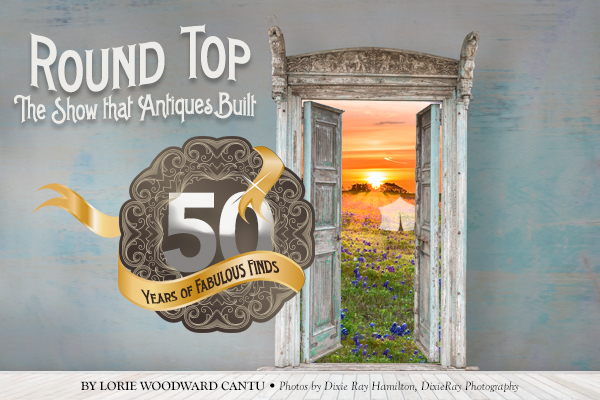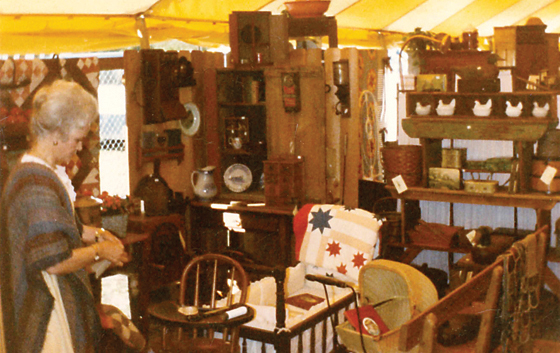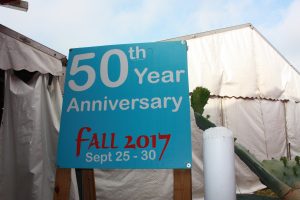Round Top Antiques Show Built on Authentic Antiques

2025 Spring Antiques Show | March 20 – April 6
2025 Fall Antiques Show | October 4 – 18
The Round Top Antiques Show, which now extends for 25 miles mostly along State Highway 237 in Fayette County, began with one woman and one building.
In the fall of 1968, Emma Lee Turney established a two-day “country antiques show with unsurpassed standards of excellence” and called it the Round Top Antiques Fair. The consummate businesswoman and Houston insider understood that the fledgling event’s success depended on mixing the business of high-end antiques with the pleasure of a much-anticipated social event.
Decades later it’s apparent that Turney was on to something.
Read what others say about those early shows in this reminiscence.
“Everything that the sprawling event now commonly known as ‘Round Top’ has become can be traced back to that original show—and fine antiques,” said Susan Franks, owner of the Original Round Top Antiques Fair held at the Big Red Barn Event Center, which is the direct descendant of that first show. “I’m not sure anyone expected the show to grow into what it has become, but Round Top will always be the ‘show that antiques built.’”
 “. . . the Round Top Show is uniquely itself. It’s always great for shopping, terrific people watching, a good excuse to go off your diet a little and a chance to walk in the boots you were born to.” – Emma Lee Turney, Denim and Diamonds: The Story of Emma Lee Turney’s Round Top Antiques Fair (1998)
“. . . the Round Top Show is uniquely itself. It’s always great for shopping, terrific people watching, a good excuse to go off your diet a little and a chance to walk in the boots you were born to.” – Emma Lee Turney, Denim and Diamonds: The Story of Emma Lee Turney’s Round Top Antiques Fair (1998)
Except for the smoke that rose from the barbecue pits at the rear of the Rifle Hall, the air was crisp and clear. It crackled with anticipation as 22 (or 24 or 26, depending on whom you ask) of the state’s top antiques dealers brought the best of their collections to Round Top the first weekend in October 1968. No contracts were signed. Merchandise was offered by those invited dealers who passed Turney’s stringent standards for authenticity and provenance.
“For Emma Lee it was fine American, including early Texas antiques, or nothing,” said Charlie Ham, who attended the earliest shows as a shopper and later, along with his mother, became one of Turney’s dealers. “Early Round Top was a purist’s show.”
Knowing their money would acquire investment-quality pieces, antiques collectors, many from the ranks of Houston’s social register, lined up and waited for Turney to open the doors and grant them access to the treasure trove of one-of-a-kind originals. Typically, the women power shopped, and the men gathered under the historic oaks swapping stories and drinking cold beer. It was not uncommon to have change from food and beer purchases counted back in German.
“It was a welcoming gathering,” said Nancy Krause, owner of Nancy’s Antiques in Brenham, who was one of the original dealers and still has a booth at the Original Round Top Antiques Fair. “It was a just a place where people wanted to come and spend their time.”
“It has been a challenge—and a great pleasure—to sponsor, manage, produce and host this country show. . . . Taking the risks, setting the standards of excellence in country show and the loyalty found in both patrons and dealers has made every minute of time and every penny of every dollar invested worth it. . . .” – Emma Lee Turney, Denim and Diamonds: The Story of Emma Lee Turney’s Round Top Antiques Fair (1998)
Collecting and selling antiques can be highly competitive, but at the early shows the competition was always friendly.
“The camaraderie that existed defies description,” Ham, who recounted tales of dealers two-stepping down the show aisles, said. “Dealers counted down the days until we could see each other and see our clients who came to this show. Clients marked it on their calendars, and it was a priority. Round Top was—and is—a relationship place.”
With that said, it certainly didn’t hurt that Ima Hogg, Faith Bybee and Hazel Ledbetter, the triumvirate of movers and shakers, preservationists and philanthropists with homes in both Houston and Round Top, supported the show and encouraged their friends to attend.
“Those women had vision and influence,” Krause said. “I’m sure it was their support, because of who they were and who they knew, that made the Round Top show the place to be.”
In 1969, Turney decided to make the show a biannual event. A few years later she added a tent at the Rifle Hall to hold more dealers.
“We were so upset because it seemed that she was cutting the pie into smaller pieces,” Krause said. “What we didn’t realize was that those new dealers would bring their clients with them, so we all benefited.”
Ham, whose booth was housed in the added tent, concurred noting the tent’s presence created a second line of attendees “four abreast and a 100 yards long” waiting to gain access to the dealers inside.
The success of the tent prompted Turney to add the Carmine Dance Hall to the mix, which then prompted other promoters to follow suit.
“Once people figured out that shoppers would drive to Carmine and later Shelby, they figured out that they’d drive just about anywhere in the area,” Ham said.
Soon after, the fields at Warrenton sprang to life bringing with it a spirit of competition of another kind. The dealers at the Rifle Hall were discouraged from exploring other venues. It became a game for them.
“We’d put on glasses and hats and sneak down to the fields avoiding any venues that fronted Highway 237,” Krause said. “When we’d bump into one another, we’d jokingly threaten to ‘tell on’ each other. It was funny—and big fun.”
From then on, the overall show grew exponentially every six months.
“It’s been something to see—and be part of,” Ham said.
As other venues staked claims on easily accessible State Highway 237, Turney made a move. In 1995, she purchased land near the junction of Texas Spur 458 and Highway 237 five miles north of Round Top and built the Big Red Barn, then and now home to the Original Round Top Antiques Fair. She sold that show and venue in 2005 to Susan Franks who continues to own and manage it today. Turney then founded the Round Top Folk Art Fair and Creative Market, now Round Top Vintage Market, which specialized in fine arts and crafts. She sold that business in 2013. Now known as Round Top Vintage Market, Barbara Griffin and Pat Boyd open the business on weekends year round.
“Emma Lee was the best businesswoman I’ve ever met,” Ham said. “When she saw that traffic patterns were changing, she changed the way she did business to ensure that she was still in the middle of things.”
“All things change, yet remain much the same. We’ve come a long way since the hand-addressed show invitation days with twenty-two dealers impatient to set up in an early dance hall. . . . ” – Emma Lee Turney, Denim and Diamonds: The Story of Emma Lee Turney’s Round Top Antiques Fair (1998)
Despite its sustained growth, increasing popularity and the collective recognition that the Round Top Antiques Show was something special, no one had an inkling of what it would become.
Today, the show encompasses more than 60 venues along both sides of State Highway 237 and spills over into surrounding communities. The twice yearly event that generally runs for two weeks and three weekends attracts about 100,000 people to both the spring and fall shows. (As a point of reference, the year-round population of Fayette County hovers around 25,000 people and 80,000 head of cattle.)
“While we knew the Round Top Show was something special, I don’t think anyone would have or could have predicted that it would grow into the place to come for antiques for people across the country and around the world,” Krause said. “A lot of changes have occurred since we got started—and the changes don’t appear to be slowing down.”
_________________________________________________________________
The Golden Anniversary of the Round Top Antiques Show
For 50 years, antiques have been part of the social and economic fabric of Round Top.
 “Everything that the sprawling event now commonly known as ‘Round Top’ has become can be traced back to that original show—and fine antiques,” said Susan Franks, owner of the Original Round Top Antiques Fair held at the Big Red Barn Event Center, which is the direct descendant of that first show.
“Everything that the sprawling event now commonly known as ‘Round Top’ has become can be traced back to that original show—and fine antiques,” said Susan Franks, owner of the Original Round Top Antiques Fair held at the Big Red Barn Event Center, which is the direct descendant of that first show.
While no one disputes that the local antiques show has been a signature event since its inception, the anniversary math gets a little confusing. Unlike marriages that log 365 days between the wedding and the first anniversary, events such as the Round Top Antiques Show get to count the first iteration, so it’s not a matter of simple subtraction. Any third grader can tell you that if you subtract 1968 from 2017, the difference is 49, but as any event planner will tell you, an annual event that began in 1968 has opened its doors 50 times; therefore, 2017 marks the Golden Anniversary of antiques in Round Top.
“I’m not sure anyone expected the show to grow into what it has become, but Round Top will always be the ‘show that antiques built,’” Franks said.
________________________________________________________________________
Why Round Top?
excerpted from Denim and Diamonds
“During the 1960s and 1970s, the Washington County area (near Round Top) became known as the ‘Brenham/Connecticut area.’ New money had been made in Houston. Second homes, weekend retreats, horse farms and vast ranches testified to the fortunes of oil barons, insurance moguls and some international financiers.
In decorating their country places, the wives of the well-to-do often turned to the safe, established styles of England and New England. Then, when the houses were fully embellished with formal and colonial antiques, fine china and silver, they begged to be admired.
But something was missing. Affluent Texans were so busy emulating the eastern establishment that they overlooked their own heritage.
Enter the preservationists—specifically three dynamic women from Houston: Miss Ima Hogg, a founder of the Houston Symphony, Hazel Ledbetter and Faith Bybee. They and their followers, life-long friends who were also interested in collecting fine antiques and in finding their place in the Texas countryside, created a stir, an awakening to the great values at hand.
Active interest in Round Top by the three influential women from Houston was highly contagious. Competition was on for city folks to acquire property, original buildings, early Texas furniture and whatever wasn’t nailed down.
Round Top citizens weren’t always sure what to make of the commotion. However, they certainly were alerted to the fact that the furniture they had been living with nonchalantly, pieces handcrafted by their grandfathers and handed down by their parents, were worth much more than mere family sentiment. They were reminded now—with some of the wares doing rough duty in barns and stables—that their predecessors had come from the old country with many valuable skills.”
_________________________________________________________________
How Round Top?
excerpted from Denim and Diamonds
“As an antiques dealer, Emma Lee already knew one of the three Ladies from Houston. One day a beautiful leather-bound Bible, published in Pennsylvania in the 18th century, caught Miss Ima’s eye. She bought it from Emma Lee and placed it in the Winedale Historical Center. Later, there were other finds for Miss Ima from Emma Lee’s Pennsylvania and Maryland trips.
Then, in the spring of 1968, came a telephone invitation from Hazel Ledbetter to come to her farm at Round Top for dinner.
‘Hazel was an excellent orchestrator and rarely did anything without a purpose,’ said Emma Lee. ‘She was a fountain of knowledge on how to do it and when to do it.’
Hazel’s direction was soon revealed. She asked Emma Lee to establish a good antiques show in Round Top so that, as she put it, ‘the public would quit peeking in our windows to see what we are doing up here.’
Emma Lee savored the logic of Hazel’s suggestion. But bringing her show to new territory so distant from regular patrons would need extra incentive, she decided, and countered Hazel’s proposal with one of her own.
‘I’ll do it,’ she told her hostess, ‘if you will open your house to the public for the weekend. And how about asking the Harvin Moores to show their restored houses?’
Architect Moore and his wife Elizabeth were among the first Houstonians to take on restoration in Texas. Emma Lee knew that antiquers from the city would be lured irresistibly by the offer to walk through those doors. Furthermore, the rush to the country had brought about 2,000 Houston families to nearby ranches, farms and weekend retreats. Many of their restored homes still wanted authentic furnishings, and owners would not be averse to seeing how Hazel and the Moores had handled their own decorating needs.
Hazel pondered briefly, weighing the invasion of privacy against her own desire for a prestigious antiques show in Round Top. The antiques won.”
________________________________________________________________________
by Lorie A. Woodward
courtesy photos
2025 Spring Antiques Show | March 20 – April 6
2025 Fall Antiques Show | October 4 – 18